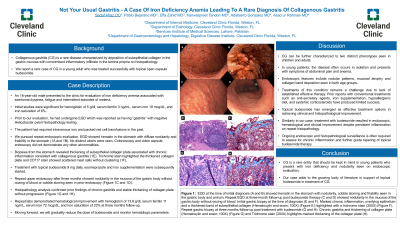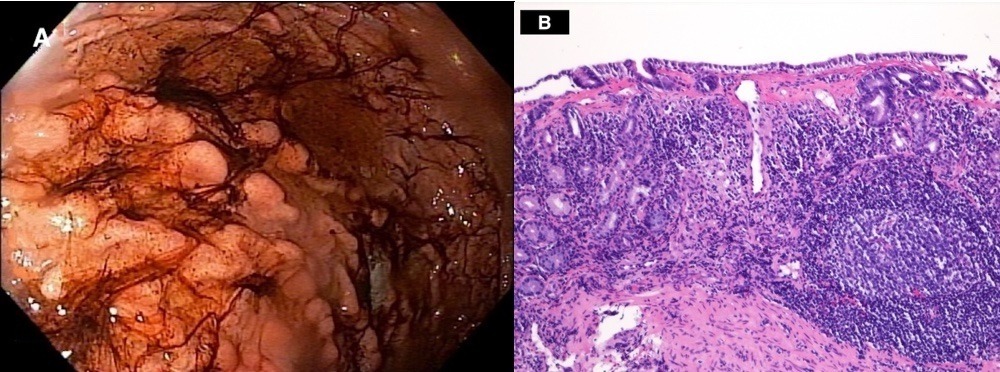Back


Poster Session C - Monday Afternoon
Category: Stomach
C0723 - Not Your Usual Gastritis - A Case of Iron Deficiency Anemia Leading to a Rare Diagnosis of Collagenous Gastritis
Monday, October 24, 2022
3:00 PM – 5:00 PM ET
Location: Crown Ballroom

Has Audio

Sadaf Afraz, DO
Cleveland Clinic Florida
Weston, Florida
Presenting Author(s)
Sadaf Afraz, DO1, Pablo Bejarano, MD1, Effa Zahid, MD2, Kanwarpreet Tandon, MD1, Adalberto Gonzalez, MD1, Asad ur Rahman, MD1
1Cleveland Clinic Florida, Weston, FL; 2Services Institute of Medical Sciences, Weston, FL
Introduction: Collagenous gastritis (CG) is a rare disease characterized by deposition of subepithelial collagen in the gastric mucosa with concomitant inflammatory infiltrate in the lamina propria on histopathology. We report a rare case of CG in a young adult who was treated successfully with topical open capsule budesonide.
Case Description/Methods: An 18-year-old male presented to the clinic for evaluation of iron deficiency anemia associated with exertional dyspnea, fatigue and intermittent episodes of melena. Initial studies were significant for hemoglobin of 5 g/dl, serum ferritin 3 ng/mL, serum iron 19 mcg/dL, and iron saturation of 6%. Prior to our evaluation, he had undergone EGD which was reported as having “gastritis” with negative Helicobacter pylori histopathology testing. The patient had required intravenous iron and packed red cell transfusions. We pursued repeat endoscopic evaluation. EGD showed hematin in the stomach with diffuse nodularity and friability in the stomach. No distinct ulcers were seen. Colonoscopy and video capsule endoscopy did not demonstrate any other abnormalities. Biopsies from the stomach revealed thickening of subepithelial collagen plate associated with chronic inflammation consistent with collagenous gastritis. Trichrome stain highlighted the thickened collagen plate and CD117 stain showed scattered mast cells without clustering. Treatment with budesonide 9 mg daily was subsequently started with clinical and hematological response on follow-up.
Discussion: CG can be further characterized to two distinct phenotypes seen in children and adults. In young patients, the disease often occurs in isolation and presents with symptoms of abdominal pain and anemia. Endoscopic features include nodular patterns, mucosal atrophy and collagen band deposition seen in both age groups. Treatments of this condition remains a challenge due to lack of established effective therapy. Prior reports with conventional treatments such as anti-secretary agents, iron supplementation, hypoallergenic diet, and systemic corticosteroids have produced limited success. Topical budesonide has emerged as effective treatment options in achieving clinical and histopathological improvement. CG is a rare entity that should be kept in mind in young patients who present with iron deficiency and nodularity seen on endoscopic evaluation. Our case adds to the growing body of literature in support of topical budesonide in treatment of CG.

Disclosures:
Sadaf Afraz, DO1, Pablo Bejarano, MD1, Effa Zahid, MD2, Kanwarpreet Tandon, MD1, Adalberto Gonzalez, MD1, Asad ur Rahman, MD1. C0723 - Not Your Usual Gastritis - A Case of Iron Deficiency Anemia Leading to a Rare Diagnosis of Collagenous Gastritis, ACG 2022 Annual Scientific Meeting Abstracts. Charlotte, NC: American College of Gastroenterology.
1Cleveland Clinic Florida, Weston, FL; 2Services Institute of Medical Sciences, Weston, FL
Introduction: Collagenous gastritis (CG) is a rare disease characterized by deposition of subepithelial collagen in the gastric mucosa with concomitant inflammatory infiltrate in the lamina propria on histopathology. We report a rare case of CG in a young adult who was treated successfully with topical open capsule budesonide.
Case Description/Methods: An 18-year-old male presented to the clinic for evaluation of iron deficiency anemia associated with exertional dyspnea, fatigue and intermittent episodes of melena. Initial studies were significant for hemoglobin of 5 g/dl, serum ferritin 3 ng/mL, serum iron 19 mcg/dL, and iron saturation of 6%. Prior to our evaluation, he had undergone EGD which was reported as having “gastritis” with negative Helicobacter pylori histopathology testing. The patient had required intravenous iron and packed red cell transfusions. We pursued repeat endoscopic evaluation. EGD showed hematin in the stomach with diffuse nodularity and friability in the stomach. No distinct ulcers were seen. Colonoscopy and video capsule endoscopy did not demonstrate any other abnormalities. Biopsies from the stomach revealed thickening of subepithelial collagen plate associated with chronic inflammation consistent with collagenous gastritis. Trichrome stain highlighted the thickened collagen plate and CD117 stain showed scattered mast cells without clustering. Treatment with budesonide 9 mg daily was subsequently started with clinical and hematological response on follow-up.
Discussion: CG can be further characterized to two distinct phenotypes seen in children and adults. In young patients, the disease often occurs in isolation and presents with symptoms of abdominal pain and anemia. Endoscopic features include nodular patterns, mucosal atrophy and collagen band deposition seen in both age groups. Treatments of this condition remains a challenge due to lack of established effective therapy. Prior reports with conventional treatments such as anti-secretary agents, iron supplementation, hypoallergenic diet, and systemic corticosteroids have produced limited success. Topical budesonide has emerged as effective treatment options in achieving clinical and histopathological improvement. CG is a rare entity that should be kept in mind in young patients who present with iron deficiency and nodularity seen on endoscopic evaluation. Our case adds to the growing body of literature in support of topical budesonide in treatment of CG.

Figure: Image A shows diffuse nodular mucosa in the gastric body on EGD. Image B shows thickening of subepithelial collagen plate associated with marked chronic inflammation.
Disclosures:
Sadaf Afraz indicated no relevant financial relationships.
Pablo Bejarano indicated no relevant financial relationships.
Effa Zahid indicated no relevant financial relationships.
Kanwarpreet Tandon indicated no relevant financial relationships.
Adalberto Gonzalez indicated no relevant financial relationships.
Asad ur Rahman indicated no relevant financial relationships.
Sadaf Afraz, DO1, Pablo Bejarano, MD1, Effa Zahid, MD2, Kanwarpreet Tandon, MD1, Adalberto Gonzalez, MD1, Asad ur Rahman, MD1. C0723 - Not Your Usual Gastritis - A Case of Iron Deficiency Anemia Leading to a Rare Diagnosis of Collagenous Gastritis, ACG 2022 Annual Scientific Meeting Abstracts. Charlotte, NC: American College of Gastroenterology.

